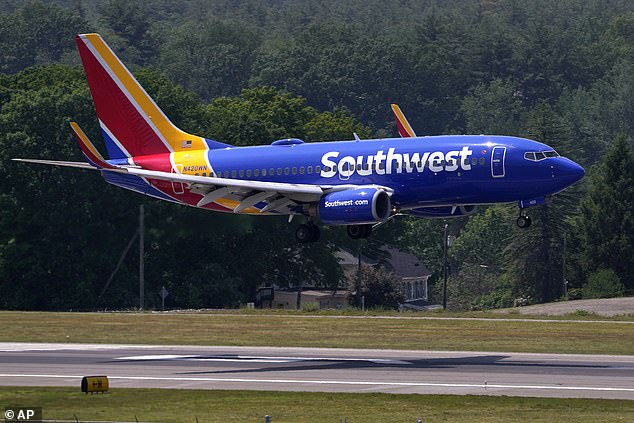Southwest Boeing 737 plunges within 500 feet of Oakland neighborhood setting off emergency alarms and terrifying residents who feared it was going to crash into their homes
A Boeing 737 plane suddenly plunged less than 500 feet into the ground of an Oklahoma neighborhood, causing residents to fear the plane would crash.
Southwest Airlines Flight 4069 was still ten miles from Will Rogers World Airport just after midnight Wednesday when records show the plane descended to an altitude of 400 to 500 feet as it flew over a high school in the Yukon city.
Doorbell camera footage shows the Boeing 737 MAX-8 then hovering over houses before flying out of view.
A resident was woken up by the plane’s engine and wondered if the plane was prepared for a collision.
“It woke me up and I thought it was going to hit my house,” the resident wrote on the Yukon Happenings Facebook page: according to The Oklahoman.
A commercial flight from the Southwest flew about 500 feet above a residential area in Oklahoma early Wednesday
The sudden drop prompted air traffic control to call the pilot and check the status of the flight.
“Southwest 4069, low altitude warning,” the air traffic controller was heard saying in a conversation audio archive of the broadcast.
“Are you okay there?” he asked.
The pilot of the commercial flight from Las Vegas confirmed there was no problem with the plane and turned around again, quickly regaining altitude from about 450 feet to more than 1,000 feet as it passed over Yukon High School.
The plane then landed safely at the airport on a different runway, and air traffic control personnel confirmed there were no problems with the Boeing 737 Max-8, according to The Oklahoman.

The pilot confirmed to air traffic controllers that there was no problem with the Boeing 737
But the low approach, along with the late hour, raised concerns among the city’s residents.
“I was kind of halfway through sleep, waking up, and I just hear that WHOOSH,” Spencer Basoco told KFOR.
“And I thought at first, like a storm was coming… because it just sounded like a wall of wind.
“And I looked out the window where the noise was coming from…if you go a few blocks away there’s the high school. And all I see is a plane,” he said.
“I knew it wasn’t normal.”
Southwest officials said they are working with the Federal Aviation Administration to determine what caused the sudden drop.
“Southwest follows its robust safety management system and is in contact with the Federal Aviation Administration to understand and address any irregularities in the aircraft’s approach to the airport,” they said in a statement.
‘Nothing is more important to Southwest than the safety of our customers and employees.’
But the sudden plunge comes as Boeing continues to make headlines for broken landing gears, broken doors in flight and faulty software systems that led to catastrophic crashes in Indonesia in 2018 and Ethiopia in 2019, killing dozens.
Boeing has made headlines in recent years for broken landing gears, broken doors in flight and faulty software systems that led to catastrophic crashes in Indonesia in 2018 and Ethiopia in 2019, resulting in dozens of deaths.
Earlier this month, a Boeing plane also experienced a rare Dutch roll: a combination of a screeching motion as the tail slips and the plane rocks from wingtip to wingtip.
As the bad news spread, it came to light that whistleblowers who had spoken out about the culture at the company had been fired.
The company’s repeated failure to fix its plentiful problems has sparked skepticism on Capitol Hill and lawmakers fired CEO Dave Calhoun for his role in the airline’s demise Tuesday.
“Rather than ask what is causing Boeing’s safety culture to erode, you and your colleagues in the C-suite have deflected blame, looked the other way and taken care of your shareholders instead,” said Senator Richard Blumenthal, a Democrat from Connecticut. .
“Boeing needs to stop thinking about the next round of revenue and start thinking about the next generation.”
